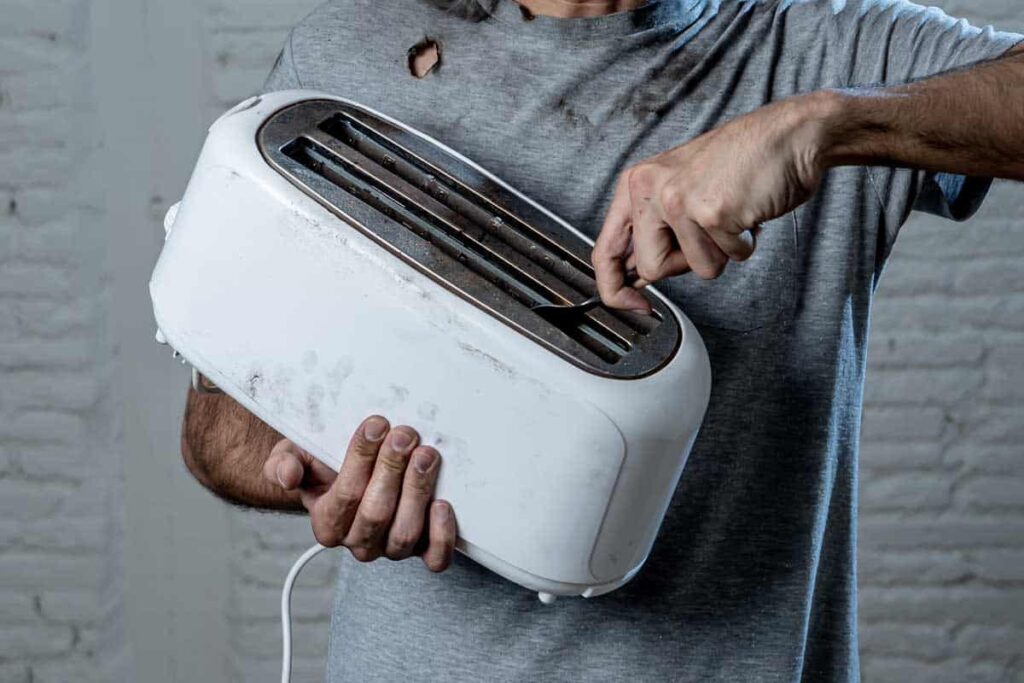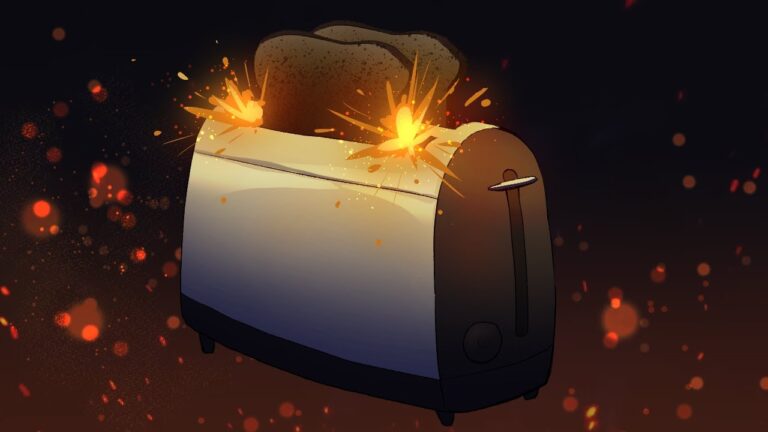Your toaster might be tripping the electric because it uses a lot of power, especially when toasting. When the electrical circuit gets overloaded, the circuit breaker steps in to stop any problems. Think of it like too many things plugged into one socket – it’s just too much for the system to handle.
Also, sometimes the wiring in the toaster or the walls can get a bit wonky, causing a short circuit that leads to tripping.
To avoid this, try not to use too many high-power appliances at once and keep an eye out for any strange smells or flickering lights, which could mean it’s time to call in a professional.
Why Is It Happening?

Sometimes, toasters trip the electricity because they use a lot of power, especially when toasting. If this power use is too much for the electrical circuit, it can make the circuit breaker turn off to keep everything safe.
How toaster usage might overload the electrical circuit
Power Consumption: Toasters draw a significant amount of power when in use. If the electrical circuit is already handling a load near its capacity, adding the toaster may exceed the limit and lead to tripping.
Simultaneous Usage: If multiple high-power appliances are running on the same circuit simultaneously, it can lead to overloading. For instance, running a toaster, microwave, and coffee maker on the same circuit might surpass its capacity.
Tips on avoiding overloading and using the toaster safely
Dedicated Circuit: Consider having a dedicated circuit for kitchen appliances to ensure they don’t overwhelm a single circuit.
Spread Usage: Avoid using multiple high-power appliances simultaneously. If you’re using the toaster, consider pausing other kitchen appliances to prevent overloading.
How faulty wiring or outlets could contribute to tripping
Loose Connections: Over time, electrical connections can become loose, leading to increased resistance and potential tripping. This can happen in the toaster’s plug, the outlet, or even within the walls.
Damaged Wiring: If the wiring inside the toaster is damaged or frayed, it can create a short circuit, leading to tripping. Similarly, if the wiring in the walls is compromised, it poses a risk.
Signs to look for and when to seek professional help
Flickering Lights or Dimming: If you notice lights flickering or dimming when the toaster is in use, it could indicate an issue. A professional inspection is advisable.
Burning Smell or Sparks: Any burning smell or visible sparks from the toaster or outlet signals a serious problem. Immediately disconnect the toaster and seek professional help.
Frequent Tripping: If the circuit breaker frequently trips when the toaster is used, it’s a clear indication of an underlying issue. A qualified electrician should investigate and address the problem.
Which Type of Toaster is Right for You?
| Toaster Type | Differences | Unique Electrical Challenges |
| Pop-Up Toasters | – Spring-loaded mechanism for toasting sliced bread. | – Limited functionality impact on electrical systems. |
| – Straightforward operation with lower power usage. | – Overuse in a shared circuit may lead to overloading. | |
| Toaster Ovens | – Multifunctional, capable of toasting, baking, and broiling. | – Variable power requirements due to multifunctionality. |
| – Broader range of functions. | – May demand higher power, potentially causing circuit strain. | |
| Convection Toasters | – Uses a fan to circulate hot air for more even toasting. | – Increased complexity with added convection feature. |
| – Enhanced even cooking. | – The fan may demand more power, affecting electrical systems. | |
| Smart Toasters | – Modern features such as timers, connectivity, or automation. | – Incorporation of sophisticated electrical components. |
| – Technologically advanced. | – Potential for increased power demands and circuit challenges. |
Considerations for Users
- Circuit Capacity Assessment: Before using a toaster, it’s essential to be aware of the specific power requirements of the appliance and whether the existing electrical circuit can accommodate it.
- Shared Circuits: Users should be cautious when using multiple kitchen appliances simultaneously, especially if they are of different types. This can prevent overloading and minimize the risk of tripping.
- Regular Maintenance: Regardless of toaster type, regular maintenance is important. Cleaning and inspecting the appliance can identify potential electrical issues before they escalate.
How the Age of the Toaster Might Affect Its Electrical Performance?

Wear and Tear on Wiring: Over time, the internal wiring of a toaster can experience wear and tear. Continuous use, exposure to heat, and general aging can lead to degradation of the wiring insulation, potentially causing electrical issues.
Corrosion and Rust: Elements such as heat and crumbs can contribute to the corrosion and rusting of internal components. Corroded connections may increase electrical resistance, affecting the toaster’s performance and potentially leading to tripping.
Technology Advancements: Older toasters may lack the safety features and technological advancements found in modern models. This can include features like automatic shutoff mechanisms, which are crucial for preventing electrical mishaps.
When to Consider Replacing an Old Toaster
Frequent Malfunctions: If your toaster is consistently malfunctioning, such as uneven toasting, inconsistent heating, or sudden power disruptions, it might be a sign of internal wear. Consider replacing it to avoid potential safety hazards.
Outdated Safety Features: Older toasters may lack the safety features present in newer models. If your toaster doesn’t have an automatic shutoff function or shows signs of wear, replacing it ensures you benefit from modern safety standards.
Energy Efficiency: Newer toasters are often designed to be more energy-efficient. If your old toaster is consuming more power than necessary or lacks energy-saving features, upgrading to a newer model can be a cost-effective and eco-friendly choice.
Changes in Toasting Performance: If you notice a decline in toasting performance, such as longer toasting times or uneven results, it could be an indication of aging components. Upgrading to a new toaster ensures consistent and efficient performance.
Consider Technological Advances: If your lifestyle has changed, and you find yourself in need of features such as smart connectivity, timers, or multiple toasting settings, it might be a good time to invest in a toaster that aligns with your current preferences and needs.
FAQ
Can a toaster cause a power surge?
Toasters typically do not cause power surges. However, if there are underlying electrical issues in your home, using multiple high-power appliances simultaneously, including a toaster, might contribute to an overload, leading to a tripped circuit breaker.
Can a dirty toaster trip the fuse?
Yes, a dirty toaster can potentially trip a fuse. Accumulated crumbs and debris inside the toaster may create a short circuit, increasing the risk of electrical problems and causing the fuse to trip.
Can a faulty toaster trip the fuse?
Yes, a faulty toaster with damaged wiring or internal issues can trip a fuse. If there are signs of malfunction, such as sparks, burning smells, or consistent tripping, it’s advisable to discontinue use and seek professional assistance.
How do I know if my appliance is tripping the breaker?
If your appliance is tripping the breaker, you may notice a sudden loss of power in the affected area. The circuit breaker switch will move to the “off” position. Resetting it may temporarily restore power, but identifying and addressing the root cause is essential.
Can a tripped fuse cause a fire?
While a tripped fuse itself doesn’t cause a fire, the conditions that lead to repeated tripping, such as overloaded circuits or faulty appliances, can pose a fire hazard. It’s crucial to investigate and address the underlying issue promptly.
How do I know if a fuse is blown?
A blown fuse may be identified by a visible break in the metal filament inside the fuse. If the fuse appears discolored or the metal strip is broken, it needs replacement. Additionally, a multimeter can be used to check for continuity.
Can a blown fuse be repaired?
No, a blown fuse cannot be repaired. Once a fuse is blown, it needs to be replaced with a new one of the same amperage rating. Attempting to repair a blown fuse can lead to safety hazards.
How do you know when a fuse needs replacing?
If a fuse repeatedly blows or if there is no continuity when tested, it needs replacing. Other signs include visible damage, discoloration, or if the connected electrical components are not functioning despite power being supplied.
What is the easiest way to check a fuse?
The easiest way to check a fuse is visually. Look for signs of a broken filament, discoloration, or visible damage. If a fuse appears intact, a multimeter can be used to test for continuity and ensure it is functioning correctly.
Final words
Why your toaster might be tripping the electricity is essential for a safe and hassle-free kitchen. Whether it’s due to overloading the circuit or issues with wiring, being aware of the potential causes empowers you to take the necessary steps.
Remember to use your toaster responsibly, avoid overloading circuits, and keep an eye out for signs of wear. If problems persist, don’t hesitate to seek professional help. By staying informed and proactive, you can ensure a reliable and safe toasting experience in your home.”

